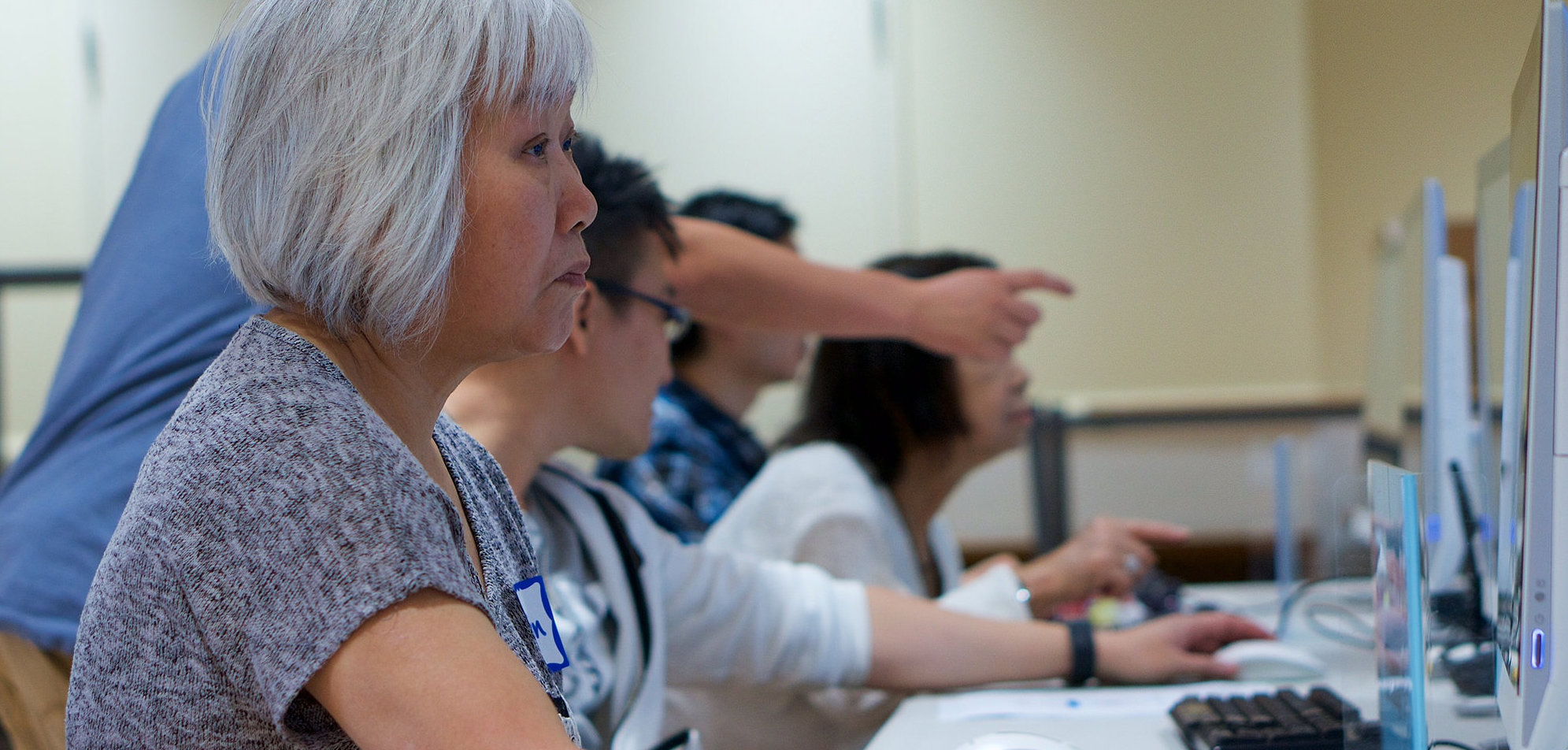This blog post by Ann Wilder (husITa board member, and Assistant Professor at Stephen F. Austin State University School of Social Work) describes one of Ann’s research interests: technology and older people.
Most everyone knows that we are living in a world that is rapidly aging. Sociologists refer to this as the grey or silver tsunami, beginning in 2011 in the US when approximately 10,000 Baby Boomers began achieving the age of 65 daily, a trend that is expected to continue until 2030. What does this mean for older adults and their families, and how can technology help build a connecting bridge and serve as a sustainer of social bonds?
According to Pew Research, older adults over the age of 65 make-up only 25-35% of the population using the internet; yet, since 2000, this age group has had the highest rate of change, especially in reported smartphone use, indicating an overall increase in technology use. In this blog post I will discuss some technological advances in the arena of aging and elder care with an emphasis on how these technologies can be applied in human services as support for older adults to live and age well.
First, I want to address social media with older adults. Today grandparents can stay connected to adult children and grandchildren through Facebook, Instagram, Twitter and other picture sharing apps. Clearly, social media has become a popular form of communication worldwide. The increasing need for medical intervention, that typically comes with aging, means that older adults frequently find themselves in situations where they have reason to use technology to communicate with professional caregivers and family members regarding their health status and other quality of life issues. Like other age groups, older adults benefit from social technology. Examples of older adults creating connectedness through social media usage cross the spectrum from generic status updates and picture sharing to personal “good night and sweet dreams” text messages to loved ones.
Training for older adults on how to use iPhones, iPads, tablets and other smart phone devices, through free classes and on-going groups at senior centers and public libraries, is also becoming more common in the developing world. Grass roots community groups assist older adults to become proficient in online communication (e.g. Blue Hair Technology Group and OATS of New York) and lists of workshops and training opportunities allow seniors to find free workshops throughout the United States (e.g. Oasis Lifelong Adventure and AARP Academy Network listing of training resources).
These are examples of how technology is being used to empower and help older adults address the rapidly advancing digital divide that often creates communication silos when adult children move farther away from home. Globalization and new economic conditions have created more career opportunities for professional working adults, which can in turn, result in needing to leave older family members in living situations where they must manage on their own. More recently, the development of apps for use with cell phones that allow older adults to maintain connection with family members and to engage in remote caregiving, monitoring and sharing of personal health information (e.g. Caring Bridge, Lotsa Helping Hands, Caring Village, Medisafe Pill Reminder & Medication Tracker) is becoming more mainstream. Again, working with a personal device, such as a smartphone, allows for a direct link to individuals that an older adult chooses they can trust as opposed to exposing themselves more openly through the internet and public social media platforms. Personal cell phone use seems to be a more trusted mode of communication when engaging in social media and is still considered a direct mode of communication with trusted individuals to help alleviate common fears of scamming or privacy invasion that sometimes occur via questionable internet sources. Privacy becomes a greater concern for this generation of technology users on both social media and health related platforms because of a higher tendency to be targeted by scams and identity thieves in the US and the UK.
Secondly, there is the aspect of communication with professional caregivers and medical providers that is becoming more common in healthcare settings where technology is leading the way in medical record keeping. Telecare, telehealth and telemedicine, combined with practitioner supported technologies, are becoming more readily used. These technological interventions serve as a buffer between older adult patients and health care providers to help manage the complexities of information and medical advances necessary in the coordination of eldercare. After all, the older you become the more likely you are to have medical problems and the more likely your doctor is to recommend frequent testing and monitoring of physical functionality. Electronic medical case records for patients began with medication and chronic disease management applications that can mirror a patient’s medical records and provide feedback on such things as diabetic self-care, medication regimes and GPS tracking of exercise activity. This allows for more open records where more than one medical professional or designated individual can view existing risks and respond acceptably. These eHealth and mHealth services are not only helping active healthy older adults age in place with dignity, they are allowing people in more rural and remote areas to receive health care services that fill gaps by providing links to resources that might not otherwise be available in less developed regions throughout the world. While each of these areas of technology use can result in structural lag, thereby increasing the digital divide for older adults, it is also allowing more opportunities for older adults to remain in home longer with higher levels of care, self-determination, and personal freedoms. Newer technologies can also help bring more resources and fill gaps related to medical and health services for older adults living in rural areas around the world.
Third, there are the components of elder care that allow for “aging in place” technology that empower older adults and families to create quasi smart home environments through integration of alarm systems, sensors, emergency and fall detection pendants, medication devices that remind, dispense and track usage, and video cameras that allow for face time chatting or synchronous sharing in social events (e.g. meals, concerts, award ceremonies, plays or sports competitions). Across the world, older adults and their family caregivers are stepping up and gaining knowledge on how to engage with technological advances now more than ever because of increase in availability and decrease in cost. Many small and reasonably priced technology devices, most frequently smartphones, are becoming available and making it easier for family caregivers to arrange “a la carte” style assisted living scenarios for their aging parents. This can allow caregivers to maintain a career long distance while staying engaged in the caring responsibilities for their own parents. With cost reduction, technology is also becoming a less expensive option for elders living in poverty that might not have access to resources and adequate healthcare. This is particularly noticeable in the developing world where resources are few and incomes for older adults are sometimes nonexistent.
Each of these topics presents what some of the current trends are for older adults and the application of technology in social settings, with personal and professional communication and emerging “aging in place” hack alternatives. Technology has the potential to empower older adults and the generation of people over the age of 65 that are currently stepping up to learn about and engage with technology. Globalization in the health care market has increased exponentially due to technology. This has created more opportunities for older adults to seek services that may not be locally available, may be less expensive or easy to combine with leisure travel and still be reimbursed by insurance (e.g. medical tourism for dental care, cosmetic or other elective surgeries). Taking into consideration the implications for privacy, ethical decision making with aging in place alternatives often presents safety concerns in the monitoring of elders staying at home longer. This has implications for medical malpractice or harm that can occur when monitoring of care is provided across state or national boundaries, all of which are things to consider when approaching technology use as social work providers. Technology continues to move faster than the human service industry’s ability to harness it. This brings about many ethical challenges demanding critical thinking and good judgment in case by case decision making with older adults who are seeking, and at times requiring, medical technology intervention. The options for elder care are innumerable with a myriad of technological devices to choose from, creating challenge and opportunity for individuals and families across the globalized world.
Follow Ann Wilder’s tweets at @annwilder
Image credit: City of Seattle Community Tech


2 comments for “Technology and aging”